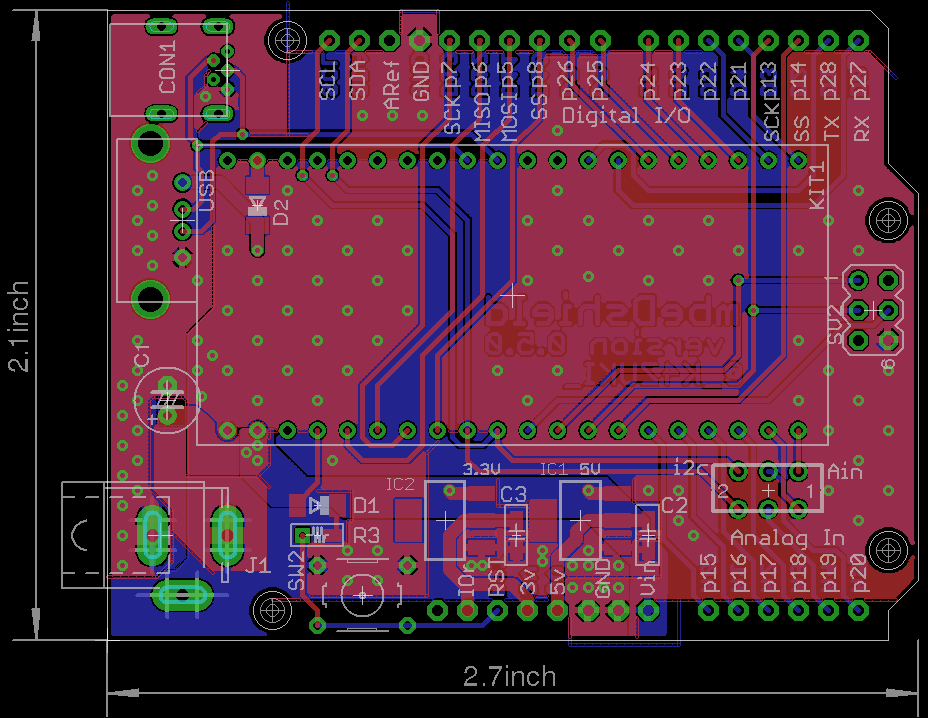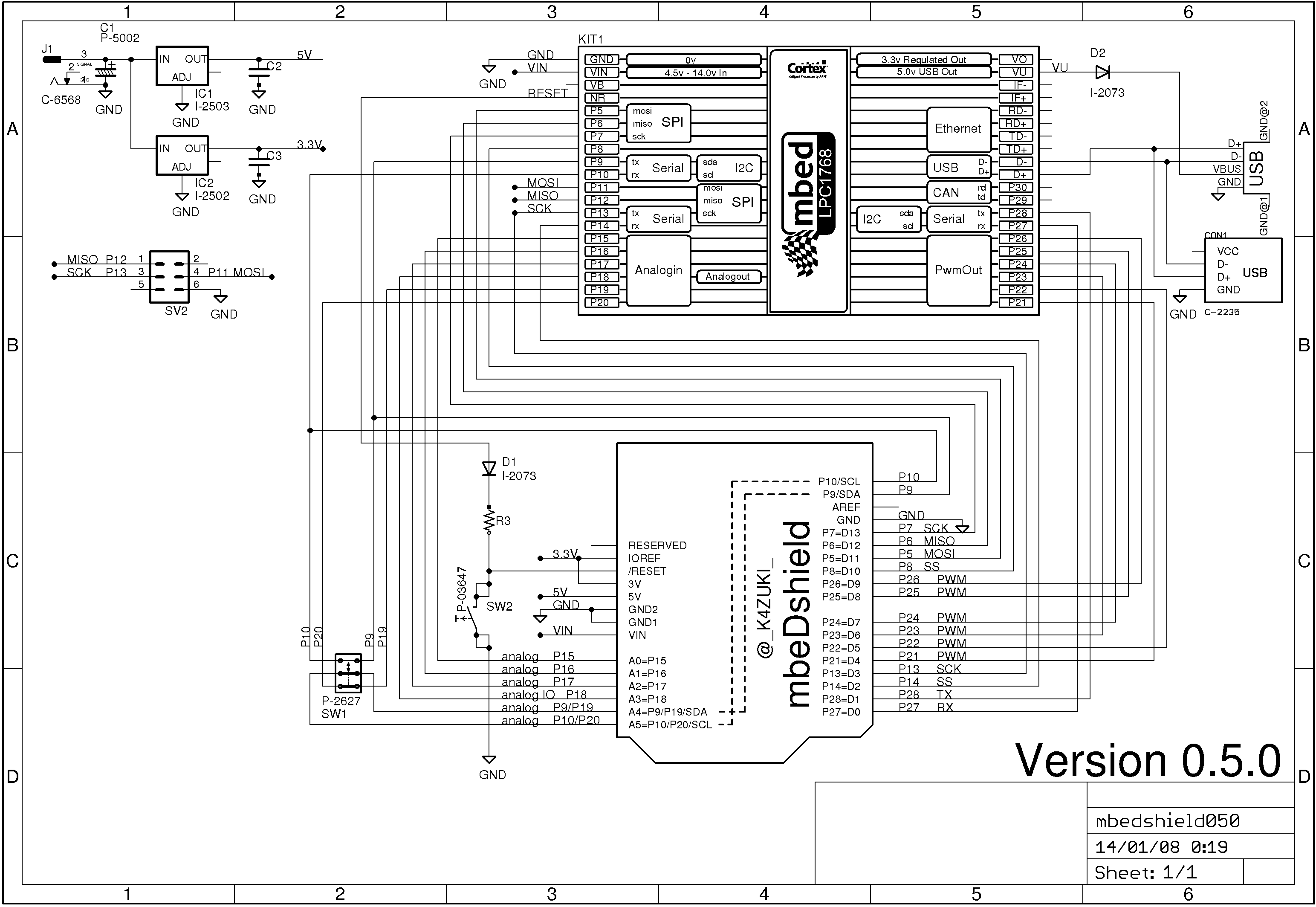The official mbed C/C SDK provides the software platform and libraries to build your applications.
Fork of mbed by
(01.May.2014) started sales! http://www.switch-science.com/catalog/1717/
(13.March.2014) updated to 0.5.0
This is a pin conversion PCB from mbed 1768/11U24 to arduino UNO.
- So if you have both mbed and arduino shields, I guess you would be happy with such a conversion board :)
Photos
- Board photo vvv

- Schematic photo vvv

- Functionality photo vvv

Latest eagle files
PCB >> /media/uploads/k4zuki/mbedshield050.brd
SCH >> /media/uploads/k4zuki/mbedshield050.sch
BIG changes from previous version
- Ethernet RJ45 connector is removed.
- http://mbed.org/components/Seeed-Ethernet-Shield-V20/ is the biggest hint to use Ethernet!
MostALL of components can be bought at Akizuki http://akizukidenshi.com/- But sorry, they do not send parts to abroad
- Pinout is changed!
| arduino | 0.4.0 | 0.5.0 |
|---|---|---|
| D4 | p12 | p21 |
| D5 | p11 | p22 |
| MOSI_ | none | p11 |
| MISO_ | none | p12 |
| SCK_ | none | p13 |
This design has bug(s)
- I2C functional pin differs between 1768 and 11U24.
Fixed bugs here
- MiniUSB cable cannot be connected on mbed if you solder high-height electrolytic capacitor on C3.
- http://akizukidenshi.com/catalog/g/gP-05002/ is the solution to make this 100% AKIZUKI parts!
- the 6-pin ISP port is not inprimented in version 0.4.0
it will be fixed in later version 0.4.1/0.4.2/0.5.0This has beenfixed
I am doing some porting to use existing arduino shields but it may faster if you do it by yourself...
you can use arduino PinName "A0-A5,D0-D13" plus backside SPI port for easier porting.
To do this you have to edit PinName enum in
- "mbed/TARGET_LPC1768/PinNames.h" or
- "mbed/TARGET_LPC11U24/PinNames.h" as per your target mbed.
here is the actual list: This list includes define switch to switch pin assignment
part_of_PinNames.h
USBTX = P0_2,
USBRX = P0_3,
//from here mbeDshield mod
D0=p27,
D1=p28,
D2=p14,
D3=p13,
#ifdef MBEDSHIELD_050
MOSI_=p11,
MISO_=p12,
SCK_=p13,
D4=p21,
D5=p22,
#else
D4=p12,
D5=p11,
#endif
D6=p23,
D7=p24,
D8=p25,
D9=p26,
D10=p8,
D11=p5,
D12=p6,
D13=p7,
A0=p15,
A1=p16,
A2=p17,
A3=p18,
A4=p19,
A5=p20,
SDA=p9,
SCL=p10,
//mbeDshield mod ends here
// Not connected
NC = (int)0xFFFFFFFF
Diff: AnalogOut.h
- Revision:
- 5:62573be585e9
- Parent:
- 4:5d1359a283bc
- Child:
- 11:1c1ebd0324fa
--- a/AnalogOut.h Thu Nov 27 16:23:24 2008 +0000
+++ b/AnalogOut.h Thu Jan 22 18:32:40 2009 +0000
@@ -1,6 +1,7 @@
/* mbed Microcontroller Library - AnalogOut
- * Copyright (c) 2007-2008, sford
- */
+ * Copyright (c) 2006-2009 ARM Limited. All rights reserved.
+ * sford
+ */
#ifndef MBED_ANALOGOUT_H
#define MBED_ANALOGOUT_H
@@ -16,8 +17,6 @@
public:
- /* Group: Configuration Methods */
-
/* Constructor: AnalogOut
* Create an AnalogOut connected to the specified pin
*
@@ -26,8 +25,6 @@
*/
AnalogOut(int pin, const char *name = NULL);
- /* Group: Access Methods */
-
/* Function: write
* Set the output voltage, specified as a percentage (float)
*
@@ -39,26 +36,16 @@
*/
void write(float percent);
- /* Function: write_v
- * Set the output voltage, specified in volts (float)
- *
- * Variables:
- * v - A floating-point value representing the output voltage,
- * specified in volts. The value should lie between
- * 0.0f (representing 0v / 0%) and 3.3f (representing 3.3v / 100%).
- * Values outside this range will be saturated to 0.0f or 3.3f.
- */
+ /* Function: write_u16
+ * Set the output voltage, represented as an unsigned short in the range [0x0, 0xFFFF]
+ *
+ * Variables:
+ * value - 16-bit unsigned short representing the output voltage,
+ * normalised to a 16-bit value (0x0000 = 0v, 0xFFFF = 3.3v)
+ */
+ void write_u16(unsigned short value);
+
void write_v(float v);
-
- /* Function: write_mv
- * Set the output voltage, specified in mili-volts (int)
- *
- * Variables:
- * mv - An integer value representing the output voltage,
- * specified in milli-volts. The value should lie between
- * 0 (representing 0v / 0%) and 3300 (representing 3.3v / 100%).
- * Values outside this range will be saturated to 0 or 3300.
- */
void write_mv(int mv);
/* Function: read
@@ -74,21 +61,20 @@
*/
float read();
- /* Group: Access Method Shorthand */
-
/* Function: operator=
- * A shorthand for <write>
+ * An operator shorthand for <write()>
*/
AnalogOut& operator= (float percent);
AnalogOut& operator= (AnalogOut& rhs);
/* Function: operator float()
- * A shorthand for <read>
+ * An operator shorthand for <read()>
*/
operator float();
- virtual const struct rpc_method *rpc_methods();
-
+ virtual const struct rpc_method *get_rpc_methods();
+ static struct rpc_class *get_rpc_class();
+
};
}
